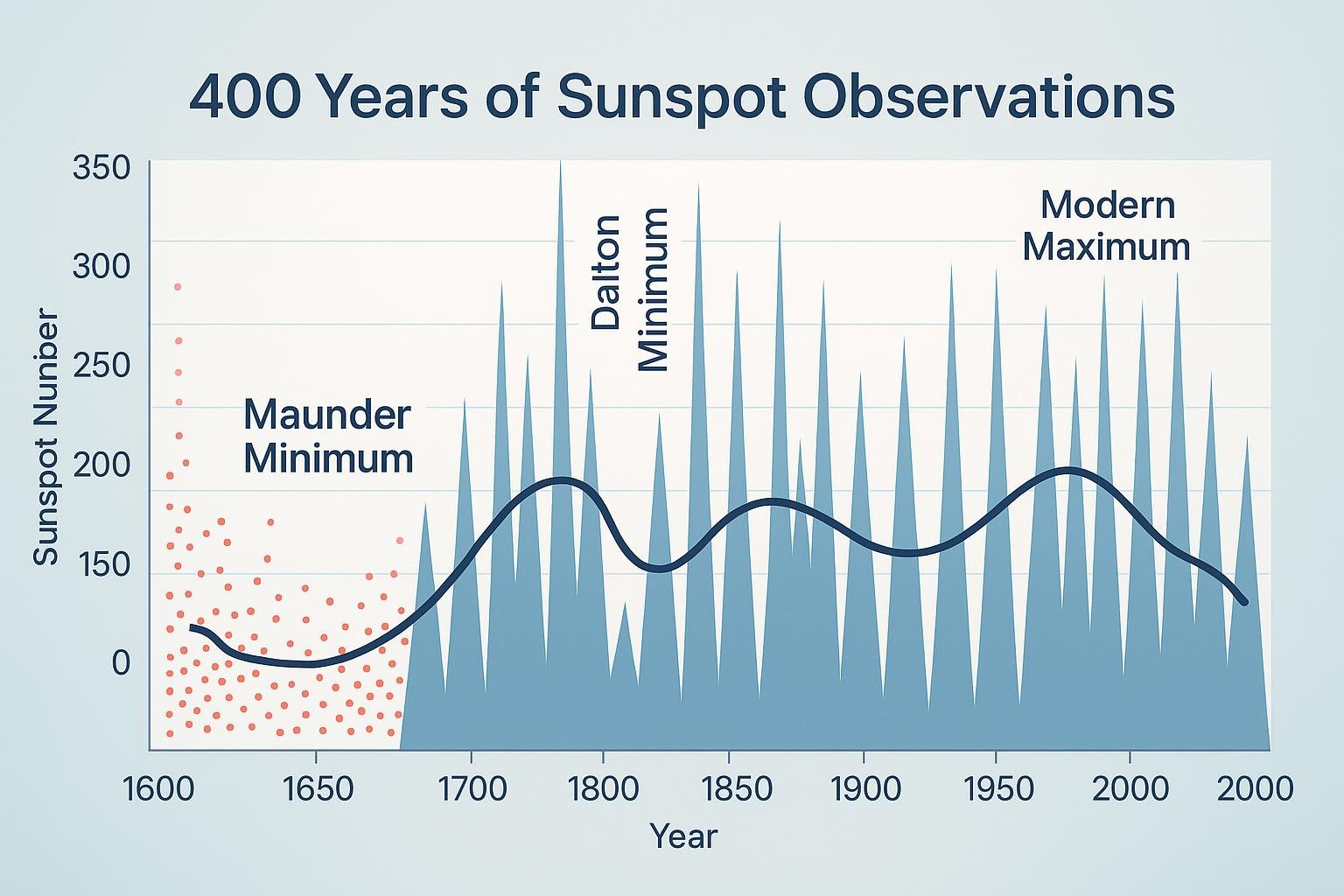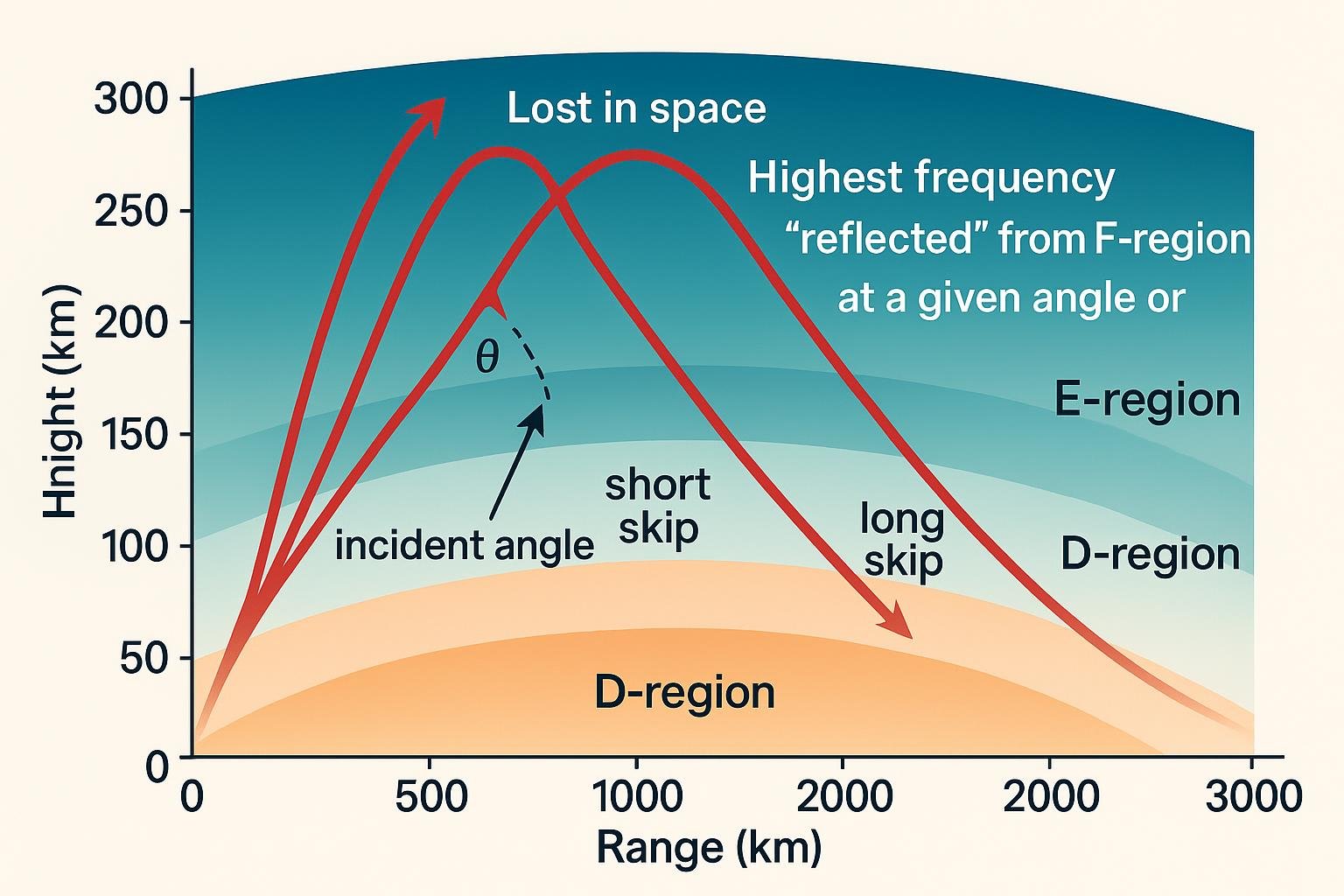The Impact Of Solar Cycle 25 On Ham Radio In Canada: Propagation, Challenges, and Opportunities
Solar Cycle 25, which began around 2019 and is approaching its peak activity phase, presents unprecedented opportunities and unique challenges for ham radio operators across Canada. This solar cycle significantly impacts radio wave propagation through enhanced ionospheric conditions, creating stronger signal paths for long-distance communication and introducing periods of increased interference and blackouts.
As solar activity continues to influence Earth's atmosphere, Canadian ham radio enthusiasts are experiencing dramatic changes in their ability to communicate across vast distances. The heightened solar activity charges the ionospheric layers that reflect radio waves to Earth, fundamentally altering how your signals travel around the globe.
Understanding these solar-driven changes is crucial for optimizing your ham radio operations, whether attempting transcontinental contacts or participating in emergency communications networks. Ham radio operators have long recognized the importance of solar cycles and sunspots in affecting Earth's atmospheric conditions and radio propagation.
Key Takeaways
- Solar Cycle 25's peak activity enhances long-distance radio communication through improved ionospheric propagation.
- Canadian ham operators face improved signal strength opportunities and increased risks of solar-induced radio blackouts.
- Understanding solar activity patterns helps optimize frequency selection and timing for reliable amateur radio communications.

Understanding Solar Cycle 25 and Its Unique Characteristics
Solar Cycle 25 began in December 2019 and is expected to reach solar maximum between 2024 and 2026, with predictions suggesting moderate activity levels similar to Solar Cycle 24. Current forecasts indicate a sunspot number peak between 115 and 125, placing this cycle in the weaker category compared to historical averages.
Key Differences Between Solar Cycle 25 and Past Cycles
Solar Cycle 25 represents a continuation of the weaker solar activity trend that began with Solar Cycle 24. Predictions of Solar Cycle 25 suggest activity levels similar to the previous cycle, marking two consecutive weak cycles.
Unlike the strong Solar Cycle 19 of the 1950s, which produced exceptional sunspot numbers exceeding 200, Solar Cycle 25 maintains the modern pattern of reduced solar output. This cycle follows the delayed minimum between cycles 24 and 25, which lasted longer than typical 11-year patterns.
Key Characteristics:
- Sunspot Number Range: 115-125 predicted maximum
- Cycle Length: Approximately 11 years (standard duration)
- Activity Level: Moderate to weak classification
- Polar Field Strength: Weaker than historical averages
The cycle's magnetic field characteristics show similarities to Solar Cycle 24, with reduced polar magnetic field strength affecting overall solar dynamo processes.
Current Status and Forecasts of Solar Cycle 25
As of August 2025, Solar Cycle 25 is approaching its solar maximum phase. Current observations show sunspot activity increasing from the solar minimum levels experienced in 2019-2020.
Upcoming Solar Cycle 25 research emphasizes understanding space weather effects as activity ramps up. Monthly sunspot numbers have been trending upward since 2021, with significant month-to-month variations typical of approaching solar maximum.
Current Indicators:
- Rising sunspot counts
- Increased solar flare frequency
- Enhanced geomagnetic activity
- Improved HF propagation conditions
The cycle's progression aligns with moderate activity predictions, though short-term variations can still produce periods of high solar activity that are beneficial for ham radio propagation.
Solar Maximum and Solar Minimum: Timeline and Predictions
Solar maximum for Solar Cycle 25 is predicted to occur between late 2024 and mid-2026, with the peak likely in 2025. This represents the period with the highest sunspot numbers and most frequent solar flares.
The previous solar minimum occurred in December 2019, marking the official start of Solar Cycle 25. During this minimum, sunspot numbers dropped to near-zero levels, creating poor HF propagation conditions for ham radio operators.
Timeline Projections:
- Solar Minimum: December 2019 (confirmed)
- Rising Phase: 2020-2024
- Solar Maximum: 2024-2026
- Declining Phase: 2026-2030
- Next Minimum: Approximately 2030-2031
Following solar maximum, you can expect a gradual decline in solar activity lasting approximately 5-6 years. This declining phase will see decreasing sunspot numbers and reduced solar flare activity, eventually leading to Solar Cycle 26's minimum around 2030-2031.

How Solar Activity Influences Ham Radio in Canada
Solar activity directly affects radio wave propagation through the ionosphere, creating opportunities and challenges for Canadian ham radio operators. Sunspot cycles drive these changes, while solar flares can disrupt communications across the country's vast geography.
The Role of Sunspots and Sunspot Activity
Sunspots create the magnetic field variations that enhance radio wave propagation on HF bands. During peak sunspot activity, you'll experience improved long-distance communication capabilities across Canada's extensive territory.
The 11-year sunspot cycle determines which frequencies work best for your operations. Higher sunspot numbers mean the ionosphere can reflect higher frequencies to Earth. This allows you to use 20-metre, 15-metre, and 10-metre bands more effectively.
Current Solar Cycle 25 Characteristics:
- Peak expected around 2024-2025
- Moderate intensity compared to previous cycles
- Enhanced propagation on higher HF bands
During sunspot maximums, you can achieve coast-to-coast Canadian contacts on unusable frequencies during solar minimums. The increased ionization supports propagation paths from British Columbia to Newfoundland on bands above 14 MHz.
Your antenna choices become more critical during high sunspot activity. Beam antennas optimized for higher frequencies provide significant advantages when sunspot numbers exceed 100.
Solar Flares and Their Effects on Communication
Solar flares cause sudden ionospheric disturbances that can completely disrupt your radio communications. Amateur radio networks have documented these ionospheric impacts through collaborative monitoring efforts.
X-class flares create radio blackouts lasting several hours across Canada's daylight regions. Your HF communications may become impossible during these events. VHF and UHF frequencies typically remain unaffected.
Flare Impact Timeline:
- Minutes 1-8: Radio blackout begins on the sunlit side
- Hours 1-3: Peak disruption period
- Hours 3-24: Gradual recovery phase
M-class flares produce moderate disruptions affecting primarily lower HF bands. You'll notice signal degradation rather than complete communication loss. These events occur more frequently than X-class flares.
Canadian operators in eastern time zones experience flare effects earlier in the day than western regions. Your local sunrise and sunset times determine when you're most vulnerable to solar flare impacts.
Seasonal and Regional Variations for Canadian Operators
Canada's high latitude position creates unique propagation challenges and opportunities throughout the year. Your location relative to the auroral zone significantly affects available communication paths.
Regional Propagation Differences:
| Region | Winter Advantages | Summer Challenges |
|---|---|---|
| Atlantic | Enhanced DX paths | D-layer absorption |
| Central | Stable mid-latitude propagation | Thunderstorm static |
| Prairies | Clear signal paths | Sporadic-E interference |
| Pacific | Asia-Pacific openings | Coastal weather effects |
Northern Canadian stations experience more frequent auroral disruptions during geomagnetic storms. These events can enhance VHF propagation while simultaneously disrupting HF communications.
Your operating schedule should account for seasonal D-layer variations. Summer months bring increased absorption on lower HF bands during daylight hours. Winter conditions favour 80-metre and 40-metre band propagation.
Grey-line propagation periods offer optimal conditions for long-distance contacts. Canadian operators benefit from extended twilight periods during spring and autumn transitions.
Ionospheric Layers and Radio Propagation During Solar Cycle 25
Solar Cycle 25's heightened solar activity dramatically alters ionospheric behaviour across all three primary layers. The increased ionization affects your radio signals differently depending on frequency and propagation path requirements.
The D Layer: Daytime Absorption Challenges
The D layer sits between 60-90 kilometres in altitude and becomes your primary concern during daylight hours of Solar Cycle 25. Enhanced solar radiation creates dense ionization that absorbs lower-frequency signals rather than reflecting them.
Your 80-metre and 160-metre band operations face significant challenges during peak solar activity. The increased free electrons in this layer absorb HF signals below 7 MHz most severely.
Key D Layer Effects:
- Morning absorption: Signals fade rapidly after sunrise
- Midday blackouts: Complete signal loss on lower bands
- Gradual recovery: Propagation returns as the D layer weakens at sunset
The impact of ionospheric conditions on radio propagation becomes particularly pronounced during Solar Cycle 25's active periods. Your best strategy involves shifting to higher frequency bands during peak solar hours.
Amateur radio operators notice the D layer's effects most dramatically on 3.5 and 1.8 MHz. These frequencies experience near-complete daytime absorption during high solar activity periods.
The E Layer: Sporadic Propagation and Short Paths
The E layer extends from 90-120 kilometres and provides your most unpredictable propagation during Solar Cycle 25. Regular E layer propagation supports reliable communication up to 2,000 kilometres on frequencies between 14-30 MHz.
Sporadic E events become more frequent during solar maximum conditions. These intense ionization patches create unexpected propagation paths on VHF frequencies typically limited to line-of-sight communication.
E Layer Characteristics:
- Maximum usable frequency: 10-50 MHz typically
- Skip distance: 500-2,000 kilometres
- Duration: Minutes to several hours
Your 20-metre and 15-metre operations benefit significantly from enhanced E layer ionization. The increased free electrons support stronger signal reflection and extended communication ranges.
Studies of ionospheric propagation effects show amateur radio operators experiencing more frequent band openings during Solar Cycle 25's peak years. VHF enthusiasts particularly notice increased 6-metre and 2-metre propagation opportunities.
The F Layer: Nighttime and Long-Distance Communication
The F layer represents your primary tool for long-distance HF communication during Solar Cycle 25. This layer splits into F1 (150-220 km) and F2 (220-800 km) components during daylight hours.
Enhanced solar activity increases the F layer's maximum usable frequency substantially. Your 10-metre through 20-metre band operations experience dramatically improved propagation conditions compared to solar minimum periods.
F Layer Advantages:
- Higher MUF: Supports 10-metre and 6-metre DX
- Extended range: Intercontinental communication is possible
- Nighttime persistence: F2 layer remains active after dark
The F2 layer becomes your most valuable propagation medium during Solar Cycle 25's peak. Increased ionization supports maximum usable frequencies often exceeding 30 MHz.
Your nighttime operations benefit from F layer persistence when D layer absorption disappears—lower frequency bands like 40 and 80 metres become viable for long-distance communication after sunset.
The ionosphere's behaviour during Solar Cycle 25 creates optimal conditions for high-frequency radio wave propagation across multiple amateur bands. Your station planning should account for these enhanced propagation opportunities throughout the solar maximum period.
Impacts of Solar Maximum and Minimum on Long-Distance Communication
Solar maximum increases ionospheric ionization, creating enhanced propagation paths for HF signals across greater distances. Solar minimum reduces ionization levels, limiting long-distance communication opportunities and requiring operators to adapt their operating strategies.
High-Frequency Band Openings During Solar Maximum
During solar maximum periods, you'll experience significantly improved propagation conditions on higher frequency bands. The increased solar radiation enhances ionospheric layers, particularly the F2 layer, creating stronger reflection paths for your signals.
You can expect regular openings on 20 metres (14 MHz) and 17 metres (18 MHz) throughout daylight hours. These conditions allow Canadian operators to maintain reliable contact with stations across multiple continents simultaneously.
Peak Performance Bands:
- 10 metres (28 MHz): Opens regularly during peak solar years
- 12 metres (24 MHz): Provides consistent DX opportunities
- 15 metres (21 MHz): Remains open longer each day
Solar radiation variations during solar maximum years create maximum variations in ionization density. This enhanced ionization supports your long-distance communication efforts.
The 27-day sunspot cycle causes predictable variations in propagation quality. These patterns repeat roughly every month, helping you plan your operating schedule around optimal conditions.
Propagation Limitations at Solar Minimum
Solar minimum brings significant challenges for your long-distance HF operations. Reduced solar flux weakens ionospheric layers, forcing you to rely primarily on lower frequency bands for reliable propagation.
You'll find that 40 metres (7 MHz) and 80 metres (3.5 MHz) become your primary DX bands. These frequencies maintain ground-wave and lower-angle sky-wave propagation even with reduced ionospheric support.
Limited Band Conditions:
- 20 metres: Opens briefly during peak daylight hours only
- 15 metres: Rare openings, primarily during equinoxes
- 10 metres: Minimal activity except for sporadic E events
Long-distance communications face significant challenges during solar minimum periods. You may experience complete fade-outs on higher bands during certain times of day.
Your operating windows become much shorter and less predictable. Morning and evening hours often provide the best opportunities for intercontinental contacts, while midday conditions may support only regional communication within North America.
As Solar Cycle 25 develops, Canadian amateur radio operators must adapt their strategies to maximize available propagation windows during peak and minimum solar activity periods.
Opportunities and Challenges for Ham Radio Operators in Canada
Solar Cycle 25 presents Canadian ham radio operators with enhanced propagation conditions alongside increased risks from space weather events. Understanding how to leverage peak solar activity while preparing for disruptions becomes essential for maintaining reliable communications.
Optimizing Operations in Periods of High Solar Activity
High solar activity during Solar Cycle 25 opens exceptional propagation windows for your HF operations across Canada's vast geography. You can achieve reliable coast-to-coast communications on higher frequency bands that remain closed during solar minimum.
The 20-metre and 17-metre bands become particularly valuable for Canadian operators. These frequencies support consistent propagation between major population centres like Vancouver, Toronto, and Halifax during daylight hours.
Peak Operating Strategies:
- Monitor 10 and 12 metres for intercontinental DX opportunities
- Use 15 metres for reliable North American coverage
- Schedule emergency communications drills during high activity periods
- Track sunspot numbers to predict optimal operating windows
Your contest scores improve dramatically during solar maximum conditions. European and Asian stations become accessible on bands that typically require night-time propagation during solar minimum.
Northern Canadian operators benefit most from enhanced propagation. In Yukon, Northwest Territories, and Nunavut, remote communities gain improved connectivity to southern Canada during peak solar conditions.
Mitigating Risks from Blackouts and Geomagnetic Storms
Solar flares and geomagnetic storms pose significant challenges for Canadian ham operations during Solar Cycle 25. Your northern latitude increases vulnerability to auroral effects and radio blackouts.
HF blackouts can persist for hours following major solar events. You must prepare backup communication methods for emergencies.
Risk Mitigation Techniques:
- Monitor space weather alerts from Environment and Climate Change Canada
- Maintain VHF/UHF equipment for local communications during HF blackouts
- Use lower frequencies (80m, 160m) during geomagnetic disturbances
- Deploy NVIS antennas for regional coverage when skip propagation fails
Geomagnetic storms affect Canada's high-latitude regions most severely. Alberta and Saskatchewan operators experience frequent auroral disruptions during active periods.
Your emergency preparedness plans should include multiple frequency allocations. When 40 metres become unusable due to absorption, 80 metres remain viable for regional traffic nets.
Digital modes like FT8 and JS8 provide communication capabilities during marginal conditions when voice modes fail.
The Science Behind Solar Cycle 25 and Earth's Atmosphere
Solar Cycle 25 directly influences Earth's atmosphere through increased solar radiation that ionizes atmospheric gases, creating the layers of charged particles essential for radio wave propagation. During this cycle, the sun's enhanced energy output produces more free electrons and ions in the ionosphere by breaking apart oxygen and nitrogen molecules.
The Sun's Energy and Ionospheric Ionization
Solar Cycle 25 represents 11 years of increasing solar activity that began in December 2019. During this cycle, the sun produces higher levels of ultraviolet and X-ray radiation that travel to Earth at the speed of light.
When this enhanced solar energy reaches Earth's atmosphere, it penetrates the ionosphere between 60 and 1,000 kilometres above the surface. Through photoionization, the radiation carries enough energy to strip electrons from neutral gas molecules.
The ionosphere consists of several distinct layers. The D layer sits lowest at 60-90 kilometres altitude. The E layer occupies 90-150 kilometres, while the F layer extends from 150-1,000 kilometres above Earth.
Solar activity affects the near-Earth space environment in measurable ways. Higher solar radiation during Solar Cycle 25 increases ionization rates across all ionospheric layers.
The F layer experiences the most dramatic changes during solar maximum periods. Electron density can increase by factors of 10 to 100 compared to solar minimum conditions.
Oxygen and Free Electrons in Ionospheric Chemistry
Oxygen plays a crucial role in ionospheric chemistry during Solar Cycle 25. Atomic oxygen (O) and molecular oxygen (O₂) dominate the upper atmosphere where ionization occurs most effectively.
Solar ultraviolet radiation breaks the bond between oxygen atoms in O₂ molecules. This process creates individual oxygen atoms and releases electrons that become free to move through the ionosphere.
Primary Ionization Reactions:
- O₂ + solar photon → O₂⁺ + free electron
- O + solar photon → O⁺ + free electron
- N₂ + solar photon → N₂⁺ + free electron
Free electrons behave differently from bound electrons in neutral atoms. They can reflect and refract radio waves, enabling long-distance communication that would otherwise be impossible.
The concentration of free electrons determines the maximum usable frequency (MUF) for radio propagation—higher electron densities during Solar Cycle 25 support higher frequency bands for ham radio operators.
Atmospheric effects vary with solar cycle phases. Peak solar activity typically produces electron densities exceeding 10⁶ electrons per cubic centimetre in the F layer.
Temperature increases accompany enhanced ionization. The ionosphere can warm by several hundred degrees Celsius during solar maximum periods, affecting the chemical reaction rates between ions and neutral particles.
Frequently Asked Questions
Solar Cycle 25 presents unique challenges and opportunities for Canadian amateur radio operators, with peak activity expected to affect propagation conditions across different frequency bands significantly. Understanding these impacts helps you prepare for changing ionospheric conditions and optimize your radio operations.
What are the predicted effects of Solar Cycle 25 on amateur radio operations in Canada?
Solar Cycle 25 will enhance high frequency (HF) propagation conditions for Canadian amateur radio operators. Increased solar activity strengthens the ionosphere's ability to reflect radio waves to Earth.
You can expect improved long-distance communications on the 20-metre and 15-metre bands during daylight hours. The 10-metre band will become increasingly active as solar activity peaks.
VHF and UHF communications may experience occasional disruptions during intense solar flares. These effects of solar activity on radio communications can cause temporary signal degradation or complete blackouts.
Canadian operators will benefit from extended propagation windows to Europe and Asia. Higher maximum usable frequencies (MUF) will allow reliable communications on previously marginal bands during Solar Cycle 24's minimum.
When is the peak of Solar Cycle 25 anticipated to occur, and how might this affect Canadian ham radio frequencies?
Solar Cycle 25 peaked in 2024, with elevated activity continuing into 2025. Peak conditions provide optimal propagation for Canadian operators on frequencies between 14 and 28 MHz.
The 15-metre band will offer excellent transcontinental propagation during daylight hours. European and Asian stations become readily accessible from Canadian locations during peak solar activity.
You'll notice the 10-metre band opening frequently for long-distance communications. This band remains closed during solar minimum but becomes highly active during peak years.
The 20-metre band will maintain reliable propagation throughout both day and night cycles. Canadian operators can expect consistent performance on this workhorse frequency during peak solar conditions.
How does Solar Cycle 25 compare to previous solar cycles in terms of intensity and impact on radio communications in Canada?
Solar Cycle 25 shows moderate intensity compared to historical cycles. Predictions suggest Solar Cycle 25 amplitude matches Solar Cycle 24, which was relatively weak compared to earlier cycles.
The current cycle produces fewer sunspots than Solar Cycle 23, which peaked around 2000-2001. Canadian operators experienced exceptional HF conditions during that stronger cycle.
Solar Cycle 25 still provides significant improvements over the recent solar minimum period. You'll notice markedly better propagation conditions than 2018-2020, when solar activity remained extremely low.
Geomagnetic disturbances during Solar Cycle 25 affect Canada's northern regions more severely. Aurora activity increases radio absorption, particularly impacting operators in territories and northern provinces.
What measures can Canadian amateur radio enthusiasts take to mitigate the effects of solar activity during Solar Cycle 25?
Monitor space weather forecasts regularly to anticipate propagation changes. Solar flux indices and K-index values help predict optimal operating conditions for your location.
Diversify your antenna systems to cover multiple frequency bands effectively. Having options across HF bands allows you to adapt quickly to changing ionospheric conditions.
Learn to operate during geomagnetic storms when northern propagation paths become unreliable. Focus on southern and equatorial paths during disturbed conditions affecting Canadian latitudes.
Amateur radio operators contribute to space weather research by reporting propagation conditions. Your observations help improve forecasting models for the amateur community.
How do variations in the solar cycle influence propagation conditions for ham radio operators in Canada?
Solar radiation ionizes atmospheric layers that reflect HF radio waves to Earth. Higher solar activity creates denser ionization, supporting propagation on higher frequencies.
The F2 layer becomes more reflective during increased solar activity. This enhancement benefits Canadian operators using frequencies above 14 MHz for long-distance communications.
Sporadic-E propagation increases during solar cycle peaks, creating unexpected VHF openings. You may experience surprising 6-metre and 2-metre propagation to distant locations.
Polar absorption events affect Canadian operators more than those at lower latitudes. These events block HF signals travelling through or near the polar regions.
How could the progression of Solar Cycle 25 alter the availability of shortwave radio frequencies used by Canadian radio amateurs?
Higher maximum usable frequencies become available as solar activity increases. Frequencies that remained unusable during solar minimum now support reliable long-distance communications.
The 10-metre amateur band transitions from closed to highly active. Canadian operators gain access to this band for transcontinental and intercontinental communications.
The 15-metre band becomes the primary DX band during peak solar conditions. This frequency offers optimal propagation characteristics for Canadian stations working worldwide.
Lower frequency bands like 40 and 80 metres experience increased absorption during daylight hours. You'll need to adjust operating schedules to accommodate these propagation changes.
The 6-metre band benefits from enhanced sporadic-E propagation during solar maximum. This VHF frequency occasionally supports long-distance communications that typically require HF bands.






